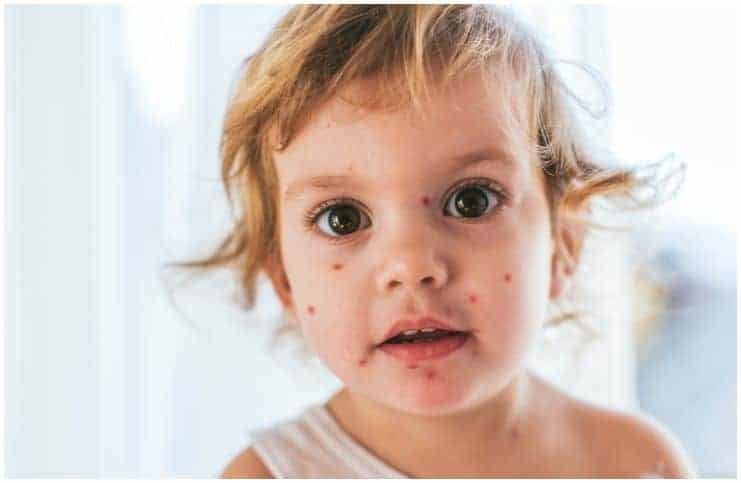Roseola vs Measles – comparison:
Roseola, also referred to as the sixth disease or roseola infantum, is a contagious condition that spreads through infected respiratory secretions.
This viral illness most commonly affects small children between 6 months and 2 years old. Newborn babies are not at high risk for this condition due to the antibodies they receive from their mothers.
This condition is so common that most children are infected with it by the time they enter kindergarten. Less frequently, older children, teens, and (very rarely) adults may be infected as well.
Symptoms
The condition usually starts with a sudden, high fever — usually greater than 39.4 C (103 F). The fever lasts 3 to 7 days. When the fever ends (usually abruptly), a pinkish-red flat or raised rash starts on the trunk.
The rash consists of many small pink patches or spots. These spots are commonly flat, however, some may be raised. The rash tends to start on the tummy, chest, and back, before spreading to the neck, face, and arms. It lasts approximately four days. It does not itch.
Other symptoms may include:
- ear pain;
- irritability;
- a sore throat;
- mild diarrhea;
- swollen glands;
- decreased appetite;
- eyelid swelling.
Due to the rapid rise or fall of body temperature, some children (approximately 10 to 15%) may experience a febrile seizure. It rarely harms the child.
Note – it may take between 5 to 15 days for a child to develop symptoms of the sixth disease after being exposed to the virus. Also, a child is most contagious before the rash occurs (during the period of high fever), making it more likely to spread among children.
Causes
This condition is caused by human herpesvirus 6, but also human herpesvirus 7. It can be very contagious and is usually spread from child to child through a cough, a sneeze, laughs, or saliva.
Infection with the sixth disease can happen at any time of the year, but most cases appear during fall or spring.
Complications
Complications are rare, except in children with suppressed immune systems. After a child has this condition, he develops lifelong immunity to HHV-6.
Diagnosis
A healthcare provider will do a physical examination, however, the diagnosis is usually uncertain until the fever goes down and a rash appears.
Treatment
Because the condition is caused by a virus, antibiotics are not effective. The best way to treat this illness is to manage the symptoms until the infection passes.
It is recommended to treat a fever over 38.5 ºC with acetaminophen or ibuprofen, following dosage instructions for your child’s weight and age. Nevertheless, both these medications have plenty of side effects.
Important note – aspirin should never be used for fever in children because a rare but potentially lethal disease may develop as a complication of aspirin intake.
Measles
Measles, also known as rubeola, is a viral infection of the respiratory system. It is an unpleasant condition, nevertheless, it usually passes without treatment within 7 to 10 days.
Symptoms
Signs and symptoms usually appear 10 to 14 days after exposure to the virus. They may include:
- inflamed eyes (conjunctivitis);
- fever (high temperature);
- a sore throat;
- a runny nose;
- a dry cough;
- Koplik’s spots – white spots with bluish-white centers found inside the mouth on the inner lining of the cheek. However, not everyone with the condition has Koplik’s spots.
Three to five days after symptoms start, a rash breaks out. This rash can last up to 7 days. The rash generally starts behind the ears and spreads over the neck and head. After a few days, this rash spreads to the rest of the body, including the legs. Also, as the spots grow, they often join together.
Note – when the rash occurs, the patient’s fever may spike to over 104° Fahrenheit. However, after a few days, the fever subsides and the rash fades.
Causes
It is caused by a virus that is spread when an infected person sneezes, coughs, or shares drinks or food.
In addition, this virus can travel through the air, meaning that a person may get this illness even if he is just near someone who has the virus. It can remain in the air for up to 2 hours after an infected individual has left a room.
The infected patient is highly contagious from 4 days before the rash appears until 4 days after the rash appears.
Complications
Although most individuals recover without problems, this illness can lead to:
- difficulty breathing;
- diarrhea;
- febrile seizures;
- vomiting;
- ear infections;
- respiratory tract infections, like – bronchitis and laryngitis;
- eye infection.
Treatment
Because this illness is caused by a virus, antibiotics are not helpful and your healthcare provider won’t give them to your child unless he also develops a bacterial infection.
Treatment is concentrated on reducing the symptoms and includes plenty of fluids (very important to prevent dehydration), rest, fever reducer medication, and pain relief if required. Also, a cool-mist vaporizer may help with the cough.
Bottom Line – Roseola vs Measles
It can be difficult to tell the difference between these similar childhood infections, but there is a difference in the appearance of the rash. For instance:
- the roseola rash is pink in color and usually starts on the abdomen before spreading to the arms, face, and legs;
- the measles rash is reddish-brown in color and commonly starts on the face before covering the entire body with blotches of bumps.
Note
Rubeola should not be confused with German measles, also called three-day measles or rubella. They share some symptoms, but they are caused by different viruses.
Image credit – Shutterstock
READ THIS NEXT: Pepcid vs Zantac
References https://www.ncbi.nlm.nih.gov/books/NBK448190/ https://academic.oup.com/jid/article/204/suppl_1/S559/2193308
